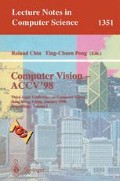Abstract
A Pose estimation system is proposed that uses an RBF network to map Gabor Wavelet Transformations (GWT) of faces to a pose angle. In particular we show (a) how the functional description of the GWT face images can be used for their parameterisation and reduction of their dimensionality and (b) how the dimensionality reduced GWT images can lead to the definition of a ridge pose space V where the face representations are sparsified and the distance measure in V correlates well with the perceived image similarity.
Preview
Unable to display preview. Download preview PDF.
References
P. Belhumeur and et al. “Eigenfaces vs fisherfaces: Recognition using class specific linear projection”. In ECCV'96.
C.M. Bishop. Networks for pattern recognition. Oxford University Press, 1995.
R. Brunelli and T. Poggio. “Face recognition: Features versus templates”. IEEE PAMI, 15(10):1042–1052, October 1993.
R. Chellapa, C.L. Wilson, and S. Sirohey. “Human and machine recognition of faces: A survey”. Proceedings of the IEEE, 83:705–740, 1995.
J. G. Daugman. “Uncertainty relation for resolution in space, spatial frequency and orientation optimized by two-dimensional visual cortical filters”. J. Opt. Soc. Am., pages 1160–1169, 1985.
B. Duc, S. Fischer, and J. Bigün. “Face authentification with sparse grid Gabor information”. In Proc. IEEE Int. Conf. ASSP, 1997.
S. Fischer, B. Duc, and J. Bigün. “Face recognition with Gabor phase and dynamic link matching for multi-modal identification”. Technical Report LTS 96.04, Signal Proc. Lab., Swiss Federal Inst. of Technology, 1996.
F. Girosi. “Some extensions of radial basis functions and their applications in artificial intelligence”. Computers and Mathematics with Applications, 24(12):6180, 1992.
S. Gong, S.J. McKenna, and J.J. Collins. “An investigation into face pose distributions”. In Proc. 2nd ICAFGR, Vermont, 1996.
S. Gong, A. Psarrou, and et al. “Head tracking and dynamic face recognition”. In European Workshop on Combined Real and Synthetic Image Processing for Broadcast and Video Production, Hamburg, Germany, 1994.
A.J. Howell and H. Buxton. “Towards unconstraint face recognition from image sequences”. In Proc of the 2nd ICAFGR, Vermont, October 1996.
N. Krüger and et al. “Determination of face position and pose with a learned representation based on labeled graphs”. Technical Report 96-03, Institut für Neuroinformatik, Ruhr-Universität Bochum, January 1996.
M. Lades and et al. Distortion invariant object recognition in the dynamic link architecture. IEEE Transactions on Computers, 42(3):300–311, 1993.
T. Maurer and C. von der Malsburg. “Tracking and learning graphs on image sequences of faces”. In Proc. ICANN, Bochum, 1996.
S.J. McKenna and S. Gong. “Real-time face pose estimation”. Submitted to Real Time Imaging Journal March 1997.
S.J. McKenna, S. Gong, R. Würtz, J. Tanner, and D. Banin. “Tracking facial feature points with Gabor wavelets and shape models”. In Proc. Audio-and video-based biometric person authentification, pages 35–42, 1997.
A. Pentland, B. Moghaddam, and T. Starner. “View-based and modular eigenspaces for face recognition”. In IEEE Proc. on CVPR, 1994.
A. Psarrou, S. Gong, and H. Buxton. “Modelling Spatio-temporal Trajectories and Face Signatures on Partially Recurrent Neural Networks”. In IEEE ICNN, Perth, Australia, 1995.
M. Turk and A. Pentland. “Eigenfaces for recognition”. Journal of Cognitive Neuroscience, 3(1), 1991.
L. Wiskott, J.M. Fellous, N. Krüger, and C. von der Malburg. “Face recognition and gender determination”. In IWAFGR, Zurich, 1995.
R.P. Würtz. “Multilayer dynamic link networks for establishing image point correspondences and visual object recognition”. Verlag Harri Deutsch, 1995.
Author information
Authors and Affiliations
Editor information
Rights and permissions
Copyright information
© 1997 Springer-Verlag Berlin Heidelberg
About this paper
Cite this paper
Psarrou, A., Tanner, J. (1997). Using RBF networks to map GWT ridge images to pose. In: Chin, R., Pong, TC. (eds) Computer Vision — ACCV'98. ACCV 1998. Lecture Notes in Computer Science, vol 1351. Springer, Berlin, Heidelberg. https://doi.org/10.1007/3-540-63930-6_180
Download citation
DOI: https://doi.org/10.1007/3-540-63930-6_180
Published:
Publisher Name: Springer, Berlin, Heidelberg
Print ISBN: 978-3-540-63930-5
Online ISBN: 978-3-540-69669-8
eBook Packages: Springer Book Archive

